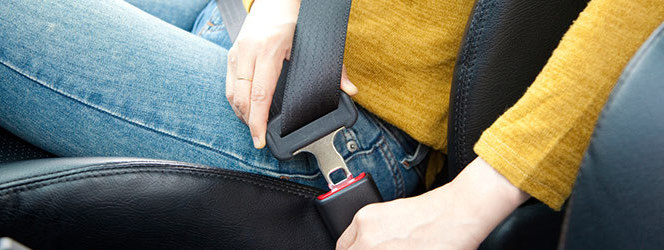Seatbelt Law
Seatbelt legislation has been in place in the UK since 1983, and nowadays, it's scary to imagine being in a car without one. It's estimated that seatbelts reduce the chance of serious injury by 50%, and in their first twenty years, seatbelts saved over 50,000 lives.

However, seatbelt law in the UK can be confusing. To help you out, car leasing specialists, Nationwide Vehicle Contracts, takes a closer look at the dos and don'ts of wearing a seatbelt for adults and children over twelve. If you're looking for information on seatbelt use for younger children, check out our child car seat guide.
This guide contains information on:
The penalties for not wearing a seatbelt are simple. If you're caught not using one, you could either face:
- A fixed penalty of £100 (could be waivered if the driver chooses to take a £52 awareness course)
- A fine of up to £500 if the case goes to court
The general rule when it comes to seatbelts is pretty simple. If your seat is fitted with a seatbelt, you must wear it. However, there are a few exceptions. You don't need to wear a seatbelt if you're:
- A driver who is reversing or supervising a learner who is reversing
- Driving a goods vehicle which is travelling no more than 50 metres between stops
- A licensed taxi driver who is 'plying for hire' or carrying passengers
- In a vehicle being used for police, fire, and rescue services
- A passenger in a trade vehicle, and you're investigating a fault
If your vehicle lease hire has broken, missing, or worn seatbelts, it will not pass its MOT. However, although all car manufacturers have had to install seatbelts since 1965, some classic cars that pre-date this do not have seatbelts. If this is the case, you're not allowed to carry children under three years old, and children over three are only allowed to sit in the back.
Medical exemptions
Your doctor may say you don't have to wear a seatbelt for medical reasons. If this is the case, they'll give you a 'Certificate of Exemption from Compulsory Seat Belt Wearing'. You must keep this in your vehicle and show it to the police if you're stopped.
If you're pregnant and are worried about wearing a seatbelt, you can apply for a medical exemption. However, you should try and wear it at all times. Here's how to wear a seatbelt comfortably way when pregnant:
- Position the belt on your hip bones and below your belly
- Position the shoulder belt between your breasts. Don't put it under your arm
- The belt needs to be tight as possible
For more information about when it is not compulsory to wear a seatbelt, visit Gov.uk.
“A seat belt is an important safety device that shouldn't be ignored. You’re twice as likely to die in a crash if you don’t wear a seat belt.”

The driver of the vehicle is responsible for making sure that they are wearing a seatbelt. They are also responsible for ensuring that all children are wearing their seatbelt.
All adult passengers over 14 years old take responsibility for wearing their seatbelt.
The below table has been produced using information from ROSPA – The Royal Society for the Prevention of Accidents. It summarises the laws relating to wearing seatbelts in private vehicles.
Person | Front seat | Rear seat | Who is responsible? |
|---|---|---|---|
Driver | Seatbelt must be worn if fitted | N/A | Driver |
Children under three years ago | Correct child restraint must be used (see ‘child car seats’ page) | Correct child restraint must be used if available (see ‘child car seats’ page) | Driver |
Children aged three years old and above, until they reach either their 12th birthday or 135cm in height | Correct child restraint must be used (see ‘child car seats’ page) | Where seatbelts fitted, correct child restraint must be used (see ‘child car seats’ page) | Driver |
Child aged 12 to 13 years old or over 135cm | Seatbelt must be worn if fitted | Seatbelt must be worn if fitted | Driver |
Adult passengers (i.e. those aged over 14 years old) | Seatbelt must be worn if fitted | Seatbelt must be worn if fitted | Passenger in question |
Animals can be a distraction when driving; that's why Rule 57 of the Highway Code states that dogs and other animals must be restrained when in a car. This can be a seatbelt, but it could also be a dog cage, dog guard, or pet carrier.
For more information, check out our blog on how to travel safely with your dog on board.
“It is a legal requirement to wear a seatbelt in the UK, and drivers caught without a seat belt face on-the-spot fines of £100. Even if you're just nipping to the shop, be sure to clip your seat belt into place.”

Minibuses and coaches
If a minibus or coach was registered after 1 October 2001, it must be fitted with forward-facing or rear-facing seatbelts.
The rules are a bit more complex for minibuses or coaches registered before 1 October 2001. If the primary purpose of the journey is to transport three or more children, the vehicle must be fitted with forward-facing seats with a three-point or lap seatbelt for each child.
Minibuses: front seats
Passengers in the front seats, or any exposed seat, must use the seatbelts provided.
Similar to laws that apply to children in cars, it's the driver's responsibility to ensure:
- Children under three years old use the appropriate restraint (see ‘child car seats’ page)
- Children between three and eleven years old, under 1.5 meters tall, use an appropriate restraint if available or wear the seatbelt that's fitted
- Children aged between 12 and 13 years old (or younger but at least 1.5 meters tall) wear the seatbelt fitted
As with cars, adult passengers over 14 years old are responsible for wearing their seatbelt.
Small minibuses: rear seats
The same rules as above apply to passengers sitting in the rear of a small minibus with an unladen weight of 2,540kg or less.
Larger minibuses: rear seats
There's no law that requires passengers in the rear seats of large minibuses – those with an unladen weight of over 2,540kg – to wear seatbelts. However, the ROSPA strongly advises they're worn on all journeys.
Coaches
All passengers sitting in seats that are in line with or in front of the driver (apart from those on an upper deck) must use fitted seatbelts.
Passengers in any other seats aren't required by law to wear a seatbelt, but it's strongly advised
Why don't normal public buses have seatbelts installed?
Passengers travelling on public fare-paying buses that are used wholly on 30mph roads are exempt from seatbelt legislation. This is because:
- Public buses used in urban areas tend to travel slowly and in dedicated bus lanes
- They travel over short distances with frequent stops
- The design of many urban buses makes it difficult to fit seatbelts
Looking to lease a car or van? Nationwide Vehicle Contracts has a range of new car leasing deals available to suit your every need.
We also offer a fast lease service, which usually comes with a delivery time of three to four weeks. For more information call one of our experts on 0345 811 9595.
Guide Information
Originally published: 19th October 2015
Last updated: 29th December 2022
